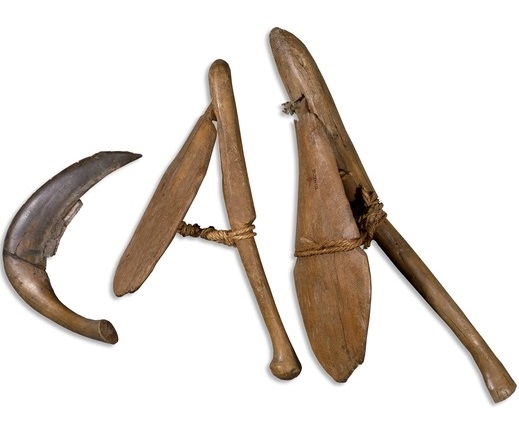Nile Valley: an Early Agrarian Society
The region near the confluence of the White and Blue Niles was conducive to and
a hotbed for large-scale farming nearly 20,000 years ago. The river's
wide-open banks were enriched with sediment from the volcanic highlands
of Central Africa carried by predictable annual floods. Devoid of freezing
temperatures and immune from most natural disasters, the Lower Nile Valley
gave birth to the oldest known organized agrarian societies.
Cultivation
Evidence of mass grain
production and storage appears
at Wadi Kubbaniya (17,000 - 15,000 BC) near Aswan in Southern Egypt (i.e., Ta Seti), where barley
grains, grinding stones, etc. were found. The region also hosts the world's oldest known
example of sorghum farming and storing along the Blue Nile in Central Sudan (i.e., Kush, 8000 - 6000 BC) at roughly the
same time period archaeologists have dated sorghum collecting near Nabta Playa in Southern Egypt (i.e., Kush, c. 6000 BC). And Swiss archaeologists found subterranean granaries near the old Kushite capital city of Kerma (i.e., Dukki Gel) in Northern Sudan
dating to the "Pre-Kerma" period (c. 4000 - 3000 BC).
It is evident that large-scale grain cultivation and storing continued through the so-called Dynastic period. In fact,
grain was so important to the populace that it was personnified by Nepri (or Neper, and closely associated with Asar or "Osiris"), who was often depicted with
drooping breasts and a large stomach to symbolize fertility and nourishment, and carrying grains and a scepter.
In the Old Kingdom, granaries became quite elaborate, as exemplified in the scale model below that dates to the 6th Dynasty (c. 2200 BC),
which is a 2-story building with multiple storage bins. The image from the tomb of Meketre, an imiperwir or "high steward"
responsible for supplying food to the suten (pharoah) and priesthood, shows several
employees grinding gains and carrying sacks of flour.
A miniature granary from Meketre's Tomb near Waset (c. 1975 BC), at the Metropolitan Museum of Art
 |
A miniature granary found near Aswan in Southern Egypt (Ta-Seti or "Nubia," c. 2200 BC), at the British Museum
 |
Cultivating along the banks of the lower Nile brought new technologies and innovative practices. Farmers used
advanced tools such as the hand plough and the flail, to aid with mass cultivation. In fact, the
hand plough and the flail were so important to the people that they both became sacred symbols
of leadership. One of the earliest known predynastic sutens, Scorpion, was depicted holding the hand plough
on the mace head found at Nekhen in Southern Egypt
(c. 3200 BC, at Oxford University's Ashmolean Museum). While sutens depicted holding the hand plough (especially on ushabti, or
funerary statuettes) diminished in Kemet after the so-called "Old Kingdom" (c. 2649-2150 BC), it was continued in Kush and in the Kushitic 25th Dynasty (c. 760-656 BC), as seen in
Aspelta's funerary ushabti (or shawabti) shown below.
Kushite suten, Aspelta (Nuri in Sudan) shown holding two hand ploughs (c. 600 BC) at the Royal Ontario Museum
 |
Scorpion holding a hand plough ("Scorpion's Macehead," c. 3100 BC), Ashmolean Museum
 |
Narmer holding a flail ("Narmer Palette," c. 3100 BC)
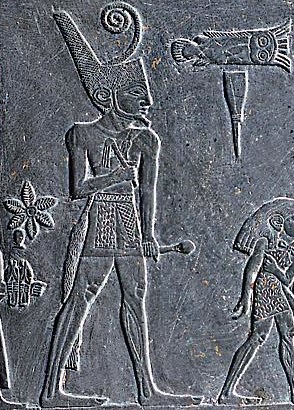 |
The flail is also depicted in
the so-called "Narmer Palette" (c. 3100 BC), as shown on the right, which
overtook the hoe as one of the two symbols Kemetic leaders used later (along with the shepherd's crook) to
convey their duty of protection of the people by providing food.
In fact, the Medu Neter ("hieroglyph") symbol
for the flail (along with an arm) meant "protection."
Moreover, the Medu Neter
symbol for suten or "pharoah" was a seated person holding a flail.
Nilotic farmers also employed ploughs in a similar manner as they are used by modern farmers. Wooden planks were arranged and
tied to oxen to create movable ploughing systems that made preparing the soil and sowing more easy and
efficient. Other tools were used for harvesting, such as one of the scenes below that depicts Sennedjem, a tomb artisan, using
a sickle to cut grains as his wife, Iyneferti, follows behind to collect (from his tomb in Deir el-Medina near Waset, c. 1300 BC). Grains like
emmer and barley were principally used for baking bread and brewing beer as represented by the figurines in an image below
from Meketre's tomb near Waset (c. 1975 BC). In addition, flax, sorghum, and various beans (i.e., pulses and fava beans), vegatables (i.e., cabbage, beets) and
fruits (e.g., grapes, watermelon, dates), were long known to be regional staples.
Farmers seeding and using hoes from a scene in the tomb of Nakht near Waset (c. 1400 BC), courtesy of Francois Guenet
 |
A 6th dynasty farmer holding a hand-plough (c. 2250 BC), at the British Museum
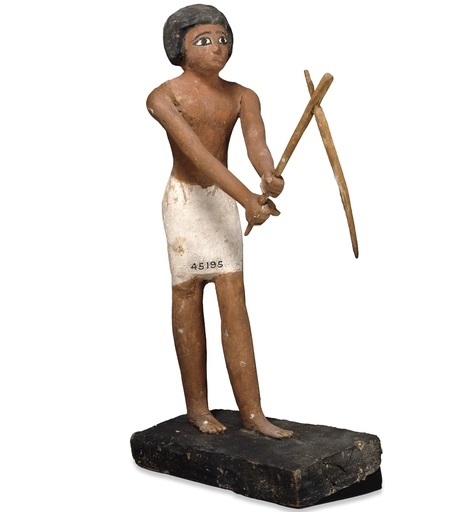 |
Sennedjem harvests grain with wife Iynefert (c. 1300 BC)
in the Metropolitan Museum of Art
 |
A farmer with an oxen plough (c. 2000 BC), at the British Museum
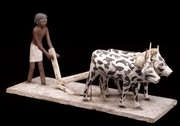 |
Baker and brewers (c. 1975 BC), at the Metropolitan Museum
 |
Farmers using pitchforks from Menna's tomb (c. 1420 BC), at the British Museum
 |
A harvest basket from the tomb of Nakht (c. 1400 BC)
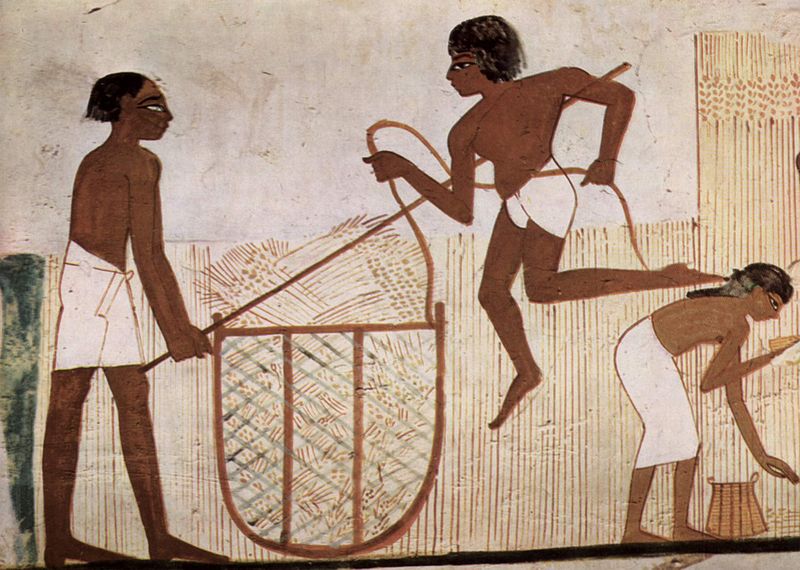 |
Water Control
Depiction of Hapi (c. 650 BC) at the Walters
Gallery of Art
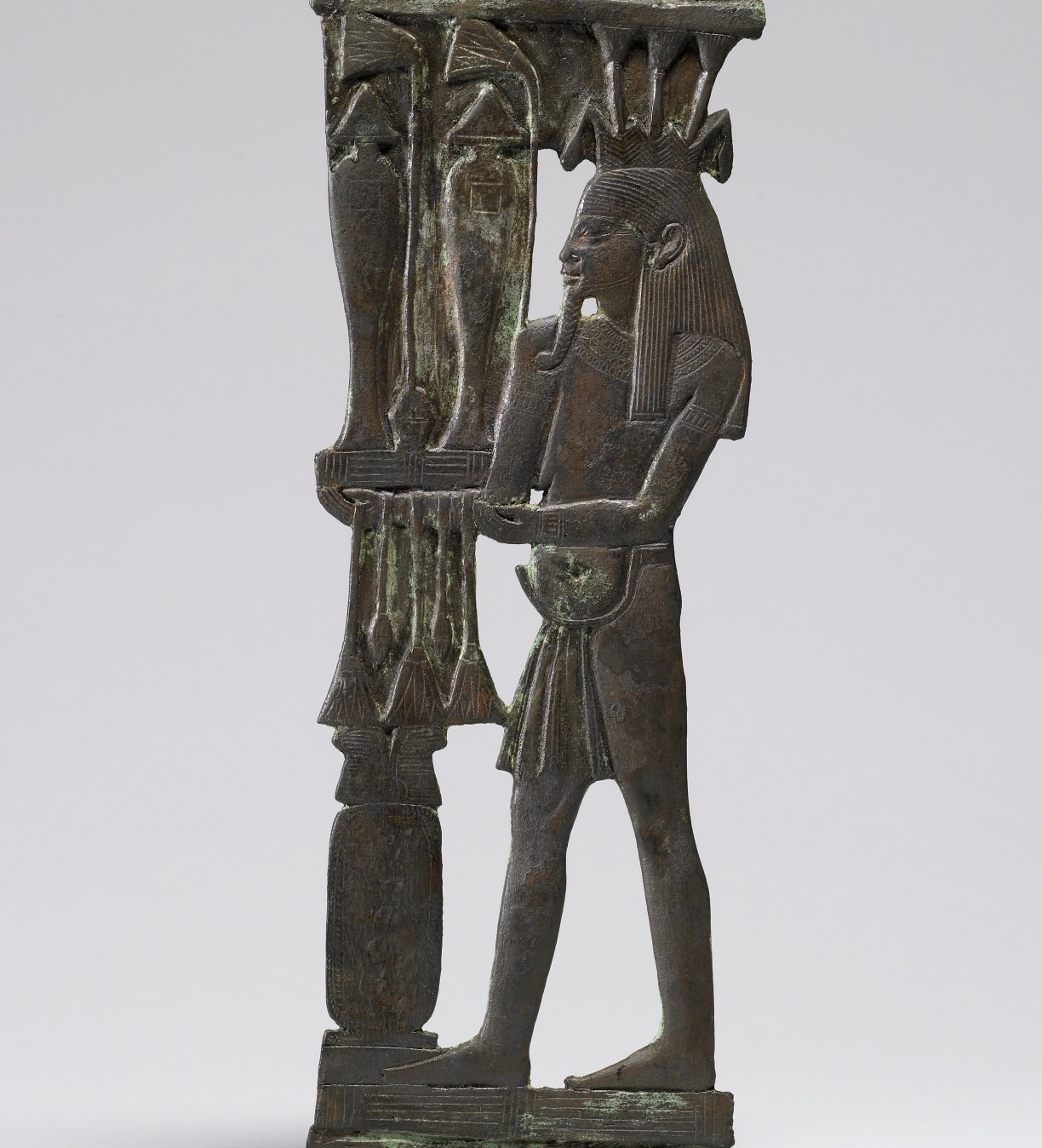 |
Despite the lack of significant rainfall in the area north of the confluence of the White and Blue Niles, the
annual inundation of the riverbanks provided fertile grounds to foster widespread cultivation. Since the livelihood
of the people depended so much on the annual floods, the essence of the floods was personified by Hapi or Hep (not to be confused with Hapy or Hapi,
the fourth son of Heru), who was generally depicted with long, drooping breasts and stomach to symbolize fertility and abundance, and wearing a headdress topped with blue water lilies (similar to lotus flowers),
a native plant of the Nile Valley. Hapi was one of the patron deities of Ta Seti ("Nubia") and its capital, Abu (Elephantine),
hosted some of the largest Hapi festivities.
Controlling water was greatly simplified by the valley's reliable three 4-month seasons: the annual
flooding during Akhet (June-September), the growing period of Peret (October-January),
and the harvesting during Shemu (February-May).
As a result, the people were able to accurately time both sowing and
reaping. However, every 5 years or so, the annual floods would be either above
or below normal levels, which could have been detrimental to annual
harvests. While storing excess grains in granaries helped avoid
widespread famine, the "nilometer" was developed to measure
the water levels of the river, which priests monitored on a daily basis
to predict any water-level abnormalities and plan for the worst. One of
the oldest nilometers was found in 2010 between the Luxor and Karnak
temples in the ancient capital city of Waset (i.e., "Thebes" or Luxor),
dating to the "New Kingdom" or roughly the reign of
Amenhotep III (c. 1350 BC), but it is uncertain precisely when this practice began.
The knowledge of the inundation cycles helped farmers and urban dwellers manage irrigation and better control the water. Since the
water level of the Nile rose over 25 feet (7.6 meters) during the height of the flood season, the people dug
canals and built earth walls to create reservoirs to keep fish or excess water for the dry season.
Irrigated fields and man-made basin from tomb of Nakh (c. 1400 BC), courtesy of SiefkinDR
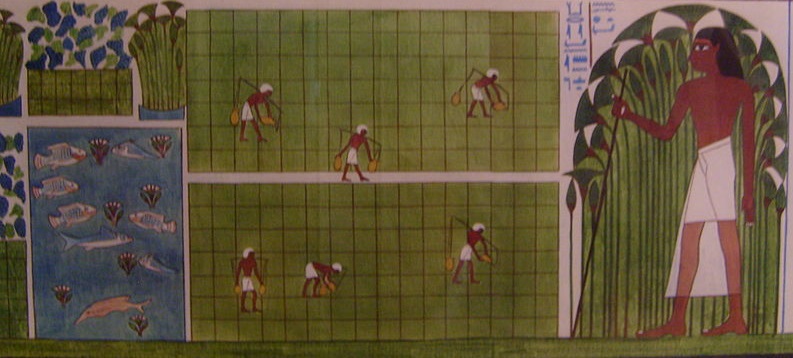 |
Land Surveying and Ownership
Land surveying, from the tomb of Nebamun near Waset (c. 1375 BC), British Museum
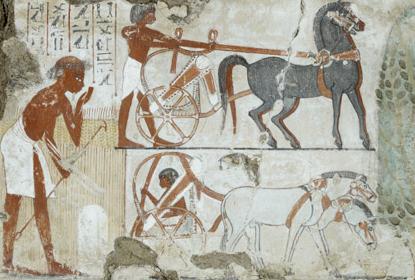 |
The annual floods coupled with the spread of large-scale farming along the banks of the Nile meant
property rights and boundaries became increasingly important. The inundations often caused confusion with property lines, and so the people
heavily relied upon land surveyors for purposes of enforcing ownership rights and land tax
assessments. The scene at right is from the tomb of Nebamun, an official grain accountant at the
Temple of Amun in Waset (c. 1350 BC). It shows an old farmer with a
sceptre laying a boundary stone and saying, "As the Great God who is in the sky endures, the boundary
stone is exact." Adjacent are scenes of two government officals on horse-drawn
chariots inspecting the fields and a land surveyor with the official title of
"Chief of the Measures of the Granary" (not shown in the image) who uses ropes to
squarely measure the fields, in a method called "rope stretching" that later spread throughout the world.
The so-called "Wilbour Papyrus" (1147 BC, Brooklyn
Museum) details such surveying with information on land assessments, quality of
land, and land owners or tenants from four
geographical groupings in central Kemet.
Thus land ownership rights were enforced. It is also apparent from several Kemetic documents that land was
transferable (i.e., people could bestow/inherit, buy/sell property), that women had just as much property
rights as men, and that there were disputes over boundaries and land ownership that were settled in court. The "lawsuit of Mose" (c. 1250 BC)
is an example of a dispute among heirs to be administrator over a family estate (Wernero, a woman with two brothers and three
sisters, was the administrator whose sister challenged her in court to have the property split evenly among the siblings).
Rope stretching to measure property dimensions from the tomb of Menna (c. 1400 BC), Metropolitan Museum of Art (reproduction; not actual)
 |
Livestock
The Nile Valley is home to the world's oldest known signs of pastoralism and animal domestication.
Evidence of cattle use was found at the Toshka Cemetery west of Abu Simbel in Southern Egypt
(Ta Seti or "Nubia," c. 13,000 BC) as well as domestication at Nabta Playa in the Nubian Desert
(12,000 - 7750 BC) west of Aswan. Ancient cattle domestication and herding is also prevalent in the region at Bir Kiseiba (c. 8400 BC),
Kerma in Northern Sudan ("Pre-Kerma" at Wadi El-Arab, c. 8500 - 7000 BC), and in Central Sudan where cattle kraal (i.e., enclosures) were also located ("Khartoum Mesolithic Culture" at El-Barga, c. 7500 BC).
These archaeological discoveries disprove long-held theories that Western Asians introduced animal domestication circa 6000 BC.
Bat, the pre-dynastic cow deity from the "Narmer Palette" (c. 3100 BC)
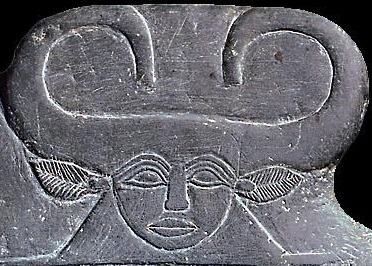 |
Like arable farming, raising livestock had tremendous cultural influence on the ancient Nilotics. The same place
where archaeologists found the oldest examples of cattle domestication (Nabta Playa) is the same place
that provides the oldest example of ceremonial burials with cows, suggesting the importance of the cow in
society. Therefore it comes as no surprise to see a cow deity depicted on the "Narmer Palette," one of the world's
oldest historical documents. The image of Bat, whose identity later became merged with that of the more famous
cow deity, Het-Heru ("Hathor"), is shown atop the Narmer Palette (on the right). The image of the more popular
Het-Heru, who was commonly depicted as either a cow or woman
with a sun between her horns, can be seen all over the Nile Valley. Further evidence of the importance
of the cow lies in the fact that it was represented as other venerated female dieties such as Aset (Isis), the
mother of the throne, and even Nut, the heavenly mother as seen in the Temple of Seti I at Abdu (Abydos). This is undoubtedly symbolic of the cow's maternal and
nurturing qualities, i.e., by providing milk.
Queen Tiye, wife of Amenhotep III, depicted as Het-Heru (c. 1355 BC) at Berlin's Egyptian Museum
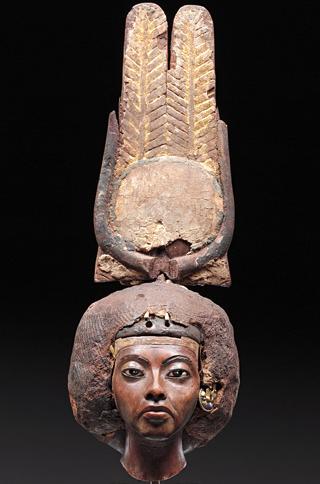 |
Amenhotep II depicted with Het Heru (c. 1450 BC) from the Het-Heru Temple of Tutmosis III
 |
Nut represented as a cow, from the Temple of Seti I, Abdu (c. 1279 BC)
 |
Meketre's stable (c. 1980 BC), at the Metropolitan Museum of Art
 |
A scene from the tomb of Ptahiruka at Saqqara (c. 2500 BC)
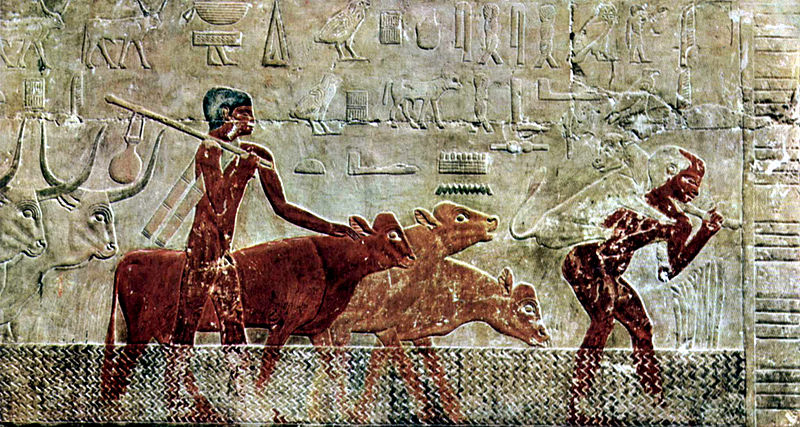 |
Nebamun herding cattle (c. 1300 BC), at the British Museum
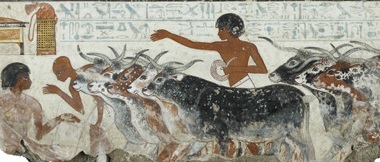 |
Continue >>









